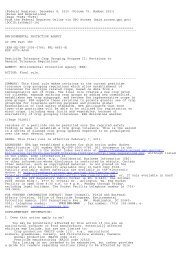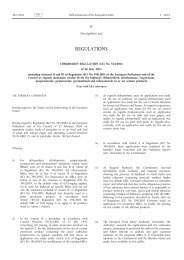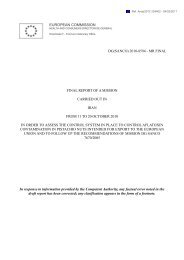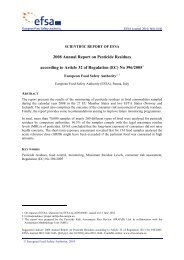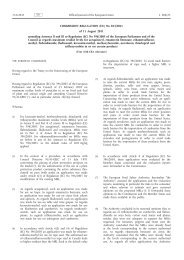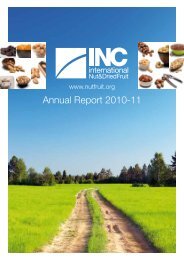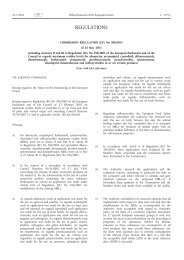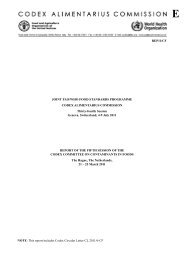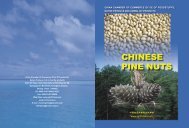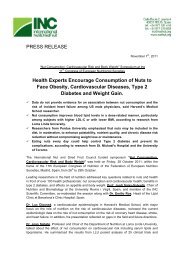final report of a mission carried out in brazil from 15 to 24 march ...
final report of a mission carried out in brazil from 15 to 24 march ...
final report of a mission carried out in brazil from 15 to 24 march ...
Create successful ePaper yourself
Turn your PDF publications into a flip-book with our unique Google optimized e-Paper software.
provided by the EMPRAPA and MAPA.In March-April 2009, a one-week tra<strong>in</strong><strong>in</strong>g session was organised by MAPA for 65 federal <strong>in</strong>spec<strong>to</strong>rs<strong>from</strong> all over Brazil. Among other th<strong>in</strong>gs, it covered the sampl<strong>in</strong>g <strong>of</strong> Brazil nuts for afla<strong>to</strong>x<strong>in</strong>control.5.3.2 The National Health Surveillance AgencyThe National Health Surveillance Agency (ANVISA) under the M<strong>in</strong>istry <strong>of</strong> Health hasresponsibility for food hygiene controls at Brazil nut processors and for afla<strong>to</strong>x<strong>in</strong> controls <strong>of</strong> Brazilnuts <strong>in</strong>tended for the Brazilian market. The <strong>mission</strong> team was <strong>in</strong>formed that ANVISA’s role <strong>in</strong> the<strong>of</strong>ficial control <strong>of</strong> the production and process<strong>in</strong>g <strong>of</strong> Brazil nuts is complementary, as it can <strong>in</strong>tervene<strong>in</strong> any situation whenever there is a health concern. In addition, under MAPA Normative InstructionNo 13/2004, MAPA and ANVISA can take jo<strong>in</strong>t action <strong>in</strong> the case <strong>of</strong> rejected or returned Brazil nutconsignments, <strong>in</strong> particular for the destruction or reuse <strong>of</strong> nuts <strong>in</strong> the domestic market.5.3.3 Cus<strong>to</strong>ms authoritiesCus<strong>to</strong>ms authorities at the po<strong>in</strong>t <strong>of</strong> export are responsible for the cus<strong>to</strong>ms clearance <strong>of</strong> Brazil nutconsignments for export.ConclusionsMAPA is designated as the ma<strong>in</strong> CA for export control <strong>of</strong> Brazil nuts, but its competence andresponsibilities are not clearly def<strong>in</strong>ed with regard <strong>to</strong> the role <strong>of</strong> VIGIAGRO. 2Progress has been made s<strong>in</strong>ce the last <strong>mission</strong>, SANCO/7074/2004, with regard <strong>to</strong> the tra<strong>in</strong><strong>in</strong>g <strong>of</strong><strong>of</strong>ficial staff <strong>in</strong>volved <strong>in</strong> the Brazil nut control cha<strong>in</strong>.5.4 PROCESS CONTROLS IN THE BRAZIL NUT PRODUCTION CHAIN5.4.1 Harvest<strong>in</strong>g, transport and warehouse s<strong>to</strong>rage conditionsAnnual Brazil nut production <strong>in</strong> Brazil is around 30 000 <strong>to</strong>nnes (2008). Of this amount, around 160<strong>to</strong>nnes <strong>of</strong> <strong>in</strong>-shell nuts were exported <strong>to</strong> the EU <strong>in</strong> 2009. This represents a significant drop <strong>from</strong>2003, when approximately 3000 <strong>to</strong>nnes <strong>of</strong> nuts <strong>in</strong> shell were exported.The <strong>mission</strong> team noted that there have been no major changes <strong>in</strong> the overall procedures <strong>of</strong> Brazilnut collection and <strong>in</strong>termediate s<strong>to</strong>rage (prior <strong>to</strong> <strong>in</strong>dustrial process<strong>in</strong>g) s<strong>in</strong>ce the last <strong>mission</strong>SANCO/2004/7074. However, the <strong>mission</strong> team noted the follow<strong>in</strong>g:• S<strong>in</strong>ce the last <strong>mission</strong>, improvements have been made <strong>in</strong> the removal <strong>of</strong> nuts <strong>from</strong> pods andtheir first dry<strong>in</strong>g. The <strong>mission</strong> team noted that, as recommended <strong>in</strong> the Codex AlimentariusCode <strong>of</strong> Practice for the prevention and reduction <strong>of</strong> afla<strong>to</strong>x<strong>in</strong> contam<strong>in</strong>ation <strong>in</strong> tree nuts(CAC/RCP 59-2005, REV.1-2006), nuts are now removed <strong>from</strong> the pods the same day whencollected and left <strong>to</strong> dry <strong>in</strong> the sun.• It may take almost 3 months <strong>to</strong> deliver collected nuts for <strong>in</strong>dustrial dry<strong>in</strong>g <strong>in</strong> process<strong>in</strong>gfacilities (s<strong>to</strong>rage <strong>of</strong> up <strong>to</strong> 40 days <strong>in</strong> the forest or community, a further 30 days <strong>in</strong><strong>in</strong>termediate s<strong>to</strong>rage facilities, up <strong>to</strong> 30 days <strong>in</strong> the nut processor before actual dry<strong>in</strong>g).However, the Standards and Trade Development Facility (STDF) project — SAFENUT —which was implemented <strong>in</strong> Brazil between 2006 and 2008, recommends that collected nutsshould be delivered quickly for <strong>in</strong>dustrial dry<strong>in</strong>g <strong>to</strong> a safe moisture content <strong>in</strong> order <strong>to</strong>2 In their response <strong>to</strong> the draft <strong>report</strong> the Brazilian Authorities noted that Normative Instruction No 11, <strong>of</strong> 22 March2010 nowdays def<strong>in</strong>es the competencies and responsibilities <strong>of</strong> VIGIAGRO (Article 20 <strong>of</strong> the NormativeInstruction).7



